Turning rubbish into electricity: Indonesia to build huge incinerators to shrink landfill needs
Sign up now: Get ST's newsletters delivered to your inbox
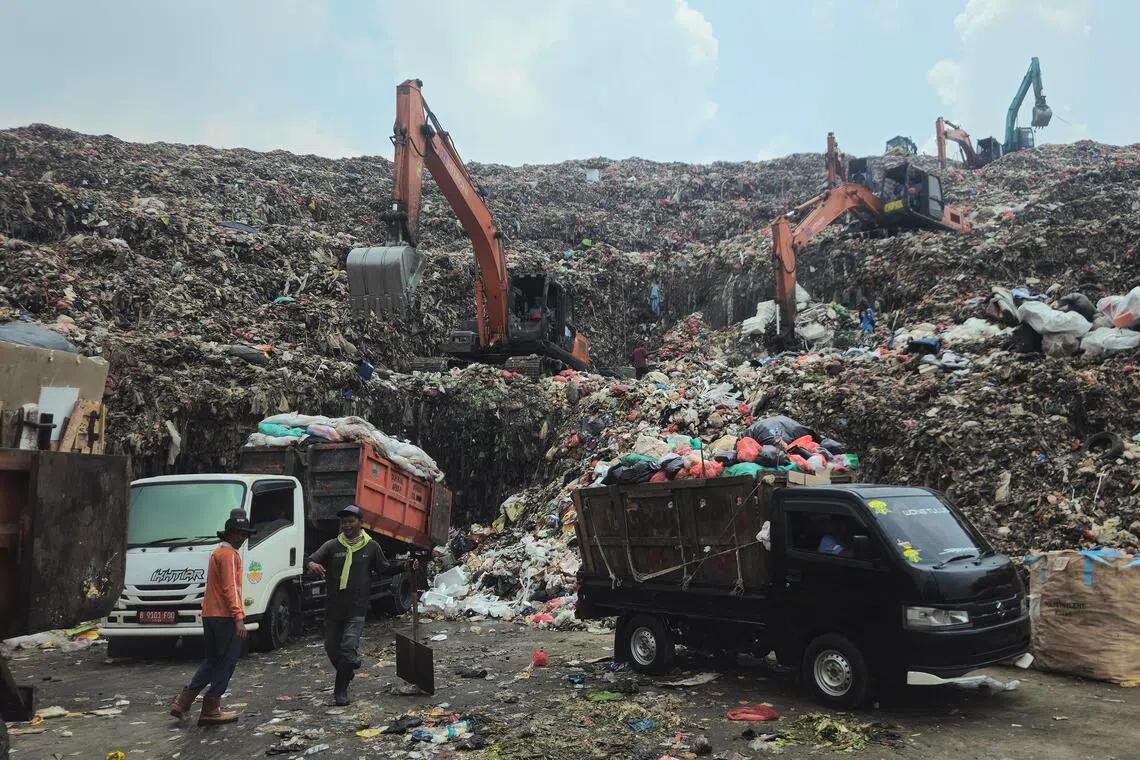
Bantar Gebang landfill in Bekasi, just outside Jakarta, receives about 8,000 tonnes of household waste every day from Jakarta.
ST PHOTO: WAHYUDI SOERIAATMADJA
Follow topic:
- Indonesia plans to build 34 waste-to-energy incinerators over the next two years to tackle its mounting waste crisis, with one of the first plants in Bantar Gebang, near Jakarta's largest landfill.
- The incinerators, costing up to $234 million each, could reduce landfill needs by 90 per cent and potentially power cities, with funding from "patriot" bonds and private-sector partnerships.
- Concerns remain about potential health risks from emissions, despite modern incinerator technology.
AI generated
BEKASI, West Java – Indonesia is planning to build large waste incinerators in 34 places over the next two years to rid the nation of the mountains of rubbish thrown daily into giant landfills.
One of the first waste-to-energy (WTE) incinerators, which can burn about 1,000 tonnes of solid waste a day, will be built in the Bantar Gebang district of Bekasi, an official told The Straits Times.
Bantar Gebang is located 25km east of Jakarta and near the country’s largest landfill, which spreads over 110ha.
Several more plants are expected to be built in the area.
“We have landfills that have piled up like mountains, such as in Bantar Gebang (that serves Jakarta), and other landfills in Bandung, Surabaya and Bali. This has become a pressing issue,” President Prabowo Subianto said on Oct 20 during a Cabinet meeting marking his administration’s first anniversary.
He added that during heavy rain, such landfills endanger
Jakarta produces some 8,000 tonnes of rubbish daily, comprising mainly household food scraps and plastic scrap. That is nearly 18 times the weight of a Boeing 747 plane and up from some 6,400 tonnes of rubbish a day produced by the city a decade ago.
Indonesia, the world’s largest archipelagic nation with 17,000 islands, generates 140,000 tonnes of waste a day.
The country has few operating incinerators, including one in Bogor with a capacity of 50 tonnes a day. The only operational large WTE plant is in East Java, with a capacity to burn 1,600 tonnes of waste a day.
The new incinerators, each expected to cost between two trillion rupiah (S$156 million) and three trillion rupiah to build, will be constructed in 34 places in the country. Among them are the Yogyakarta special region, Bogor in West Java province and Semarang in Central Java province.
“If burying rubbish means burying our future, then the answer is simple: Stop burying it. What do you do when the rubbish keeps piling up and the land runs out?” said an Oct 6 note to investors by the government’s flagship wealth fund Daya Anagata Nusantara (Danantara).
“In some way, you can burn the problem. But the key is to burn it in the right way. The smart way,” it added.
The WTE facility is said to be able to transfer the heat from the garbage-burning to boil water and turn it into steam in special pipes to spin a turbine to generate electricity.
Each plant could “shrink landfill needs by 90 per cent over time. If large enough, some plants can even light up a mid-sized city”, the Danantara note also said.

The 110ha landfill near Jakarta, one of South-east Asia’s largest, has been operating since 1989 and is nearing its maximum capacity.
ST PHOTO: WAHYUDI SOERIAATMADJA
The sovereign wealth fund launched in February 2025
“This is a direct order from the President to solve the waste problem. For decades, the waste issue has remained unresolved,” he said.
ST understands that among the foreign companies Danantara is considering working with are France’s Veolia Environment and China’s Zhejiang Weiming Environment Protection.
The WTE projects will be open to interested foreign investors, Mr Angga noted.
He said the main source of funding would primarily be the proceeds of 50 trillion rupiah from the recent sale of government-issued securities, or so-called “patriot” bonds, to local tycoons.
Indonesia is facing a worsening waste crisis, producing rubbish faster than it can manage. The handling of solid waste is decentralised, being under the purview of more than 500 regions – each led by either a mayor or regent.
Danantara will thus have to deal with these separate entities in its plan to build an incinerator in the various regions. Electricity generated from the incinerators will be sold to PLN, the state power utility.
However, concerns remain about potential health risks from emissions despite modern incinerator technology. Thus, incinerators might not be welcomed by all, though the modern ones have devices to convert pollutant gases into less harmful ones in closed systems with air controls.

Residents living near the edge of the Bantar Gebang landfill face potential health risks.
ST PHOTO: WAHYUDI SOERIAATMADJA
In many countries, communities near incinerators often worry about respiratory diseases and cancer risks as emissions from these plants cannot be 100 per cent contained.
Analysts say it is about choosing the option that causes the least negative impact.
Asked about the pros and cons of the waste-to-energy project, Mr Gundy Cahyadi, research director at Jakarta-based think-tank Prasasti Centre of Policy Studies, said the problem of waste management in Indonesia would be enormous if no action is taken.
“The progress in waste management in Indonesia has practically been nil,” he told ST.
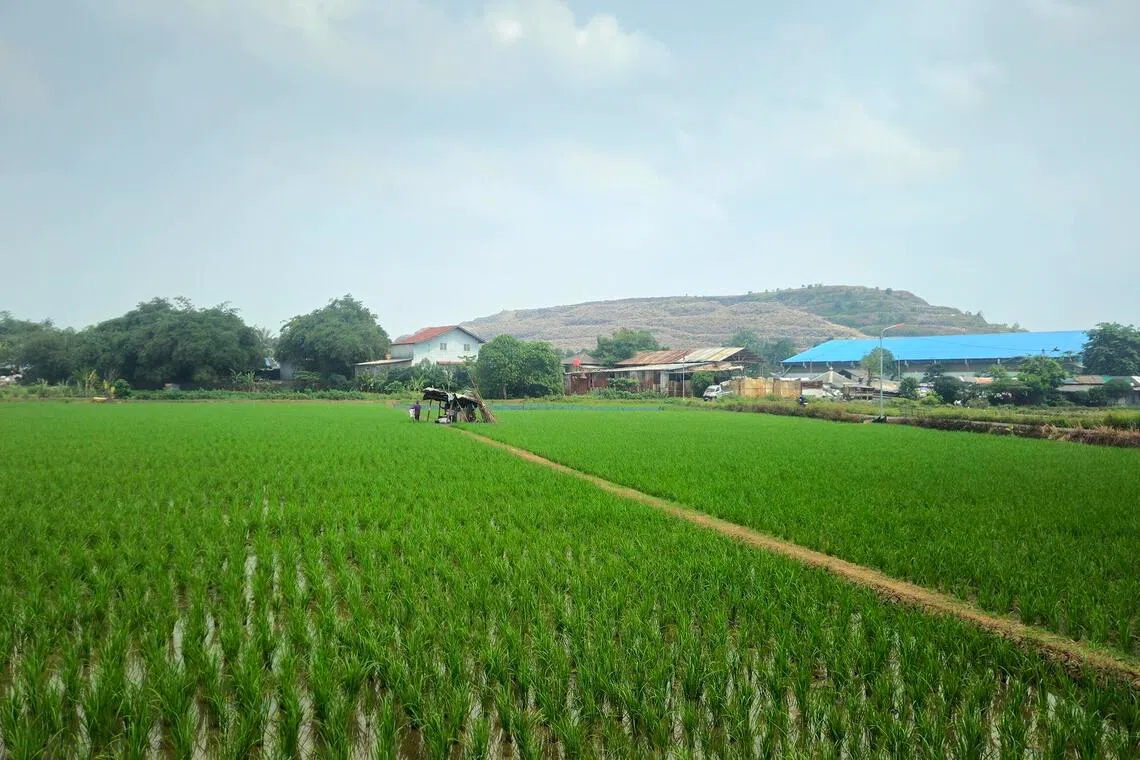
Bantar Gebang landfill looming behind a 7,000 sq m paddy field.
ST PHOTO: WAHYUDI SOERIAATMADJA
In Indonesia, the ever-expanding landfills have been deadly and have caused health problems in recent years.
The 2005 Leuwigajah landfill disaster in West Java buried 70 homes and killed more than 150 people. In the same province in 2023, the Sarimukti blaze left more than 600 people suffering from acute respiratory illness.
In Bali, Indonesia’s main tourist island, the Suwung landfill stopped receiving waste in August after repeated fires, and severe waste accumulation exceeded 30m in height in some areas.
For the 70,000 people living near Indonesia’s largest landfill in Bantar Gebang, environmental and health hazards are a daily worry.
“Our well water doesn’t taste right. It has a funny and strong sour taste. We use it only for bathing,” Mrs Sarni Nain, 69, told ST on Oct 15.
Her house is only about 100m from the edge of the landfill. “We buy clean water and boil it for drinking,” she said.
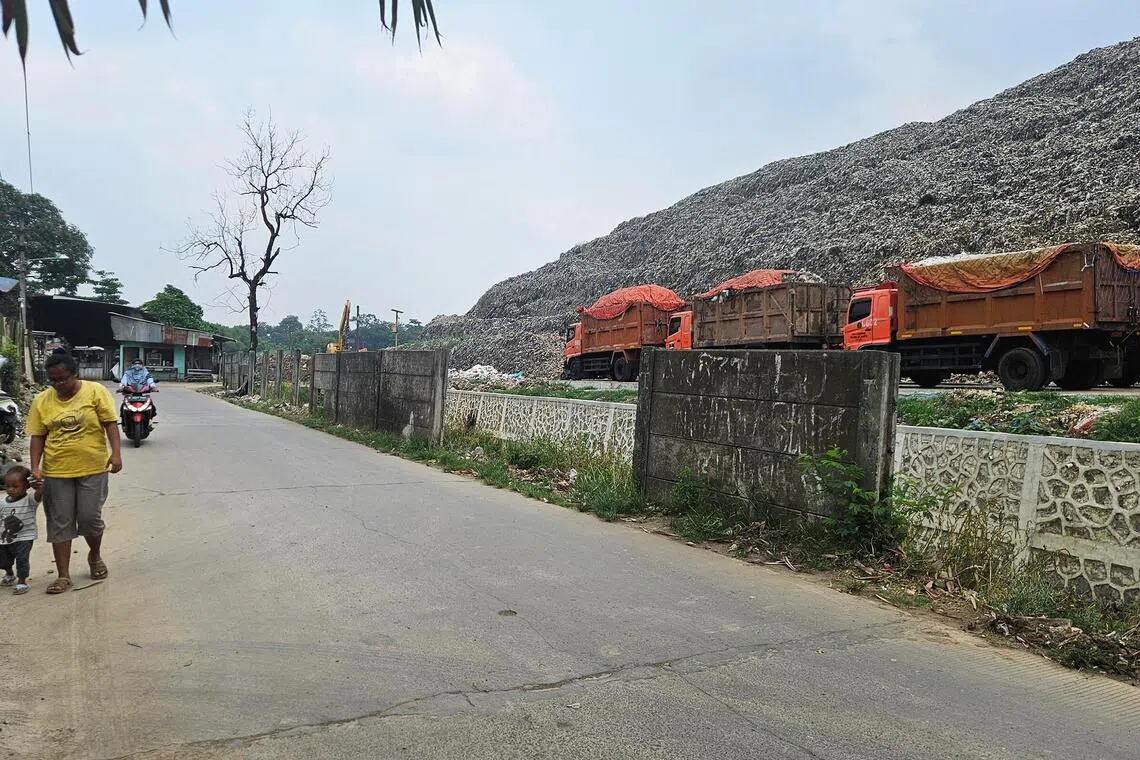
Residents living near the edge of the Bantar Gebang landfill have to buy drinking water because the groundwater, which many Indonesians usually boil before drinking, tastes acidic.
ST PHOTO: WAHYUDI SOERIAATMADJA
Toxic and acidic liquid could form when rainwater passes through waste and seeps into soil and groundwater, a particularly dangerous issue as most Indonesians still rely on pumped-up groundwater for their supply of clean water, including for drinking, experts say.
Those in rural areas depend mainly on water from wells.
Decomposing waste also releases methane and hydrogen sulphide, causing foul smells and sometimes respiratory irritation. Methane is highly flammable and contributes to greenhouse gas emissions, worsening climate change.
The giant Bantar Gebang landfill in Bekasi has been operating since 1989 and is now nearing its maximum capacity.
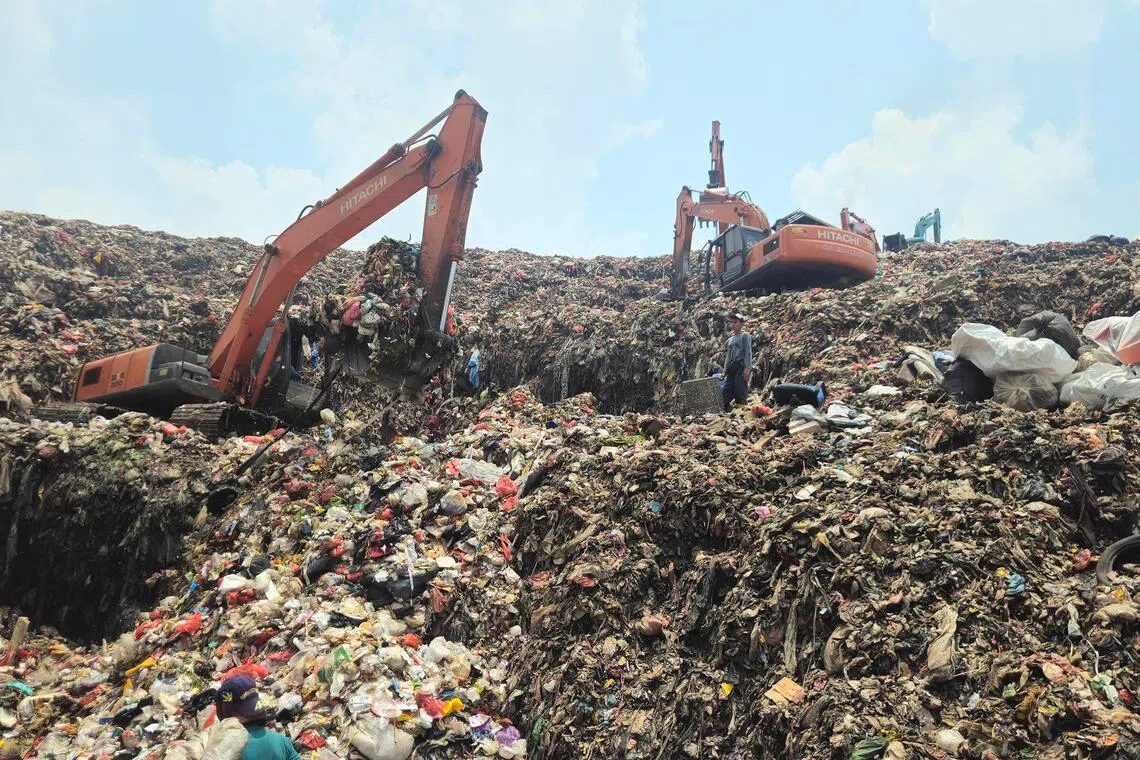
The giant Bantar Gebang landfill in Bekasi has been operating since 1989 and is now nearing its maximum capacity.
ST PHOTO: WAHYUDI SOERIAATMADJA
Hundreds of tonnes of rubbish there collapsed and killed several people in September 2006, leaving residents with a lasting sense of trauma. The landfill has accumulated 55 million tonnes, according to government data.
Yet, near the landfill, children still run around, some barefoot, exposing themselves daily to toxic waste and unknowingly putting themselves at risk of infection.
For those from outside Bekasi and struggling to get jobs in Greater Jakarta, Bantar Gebang has become their home.
Around the landfill, an estimated 6,000 scavengers have set up waste-collection sites. A woman who declined to disclose her identity has been seen by ST sorting used plastic bottles for recycling as her baby slept in a makeshift swing beside her at one of the collection sites.
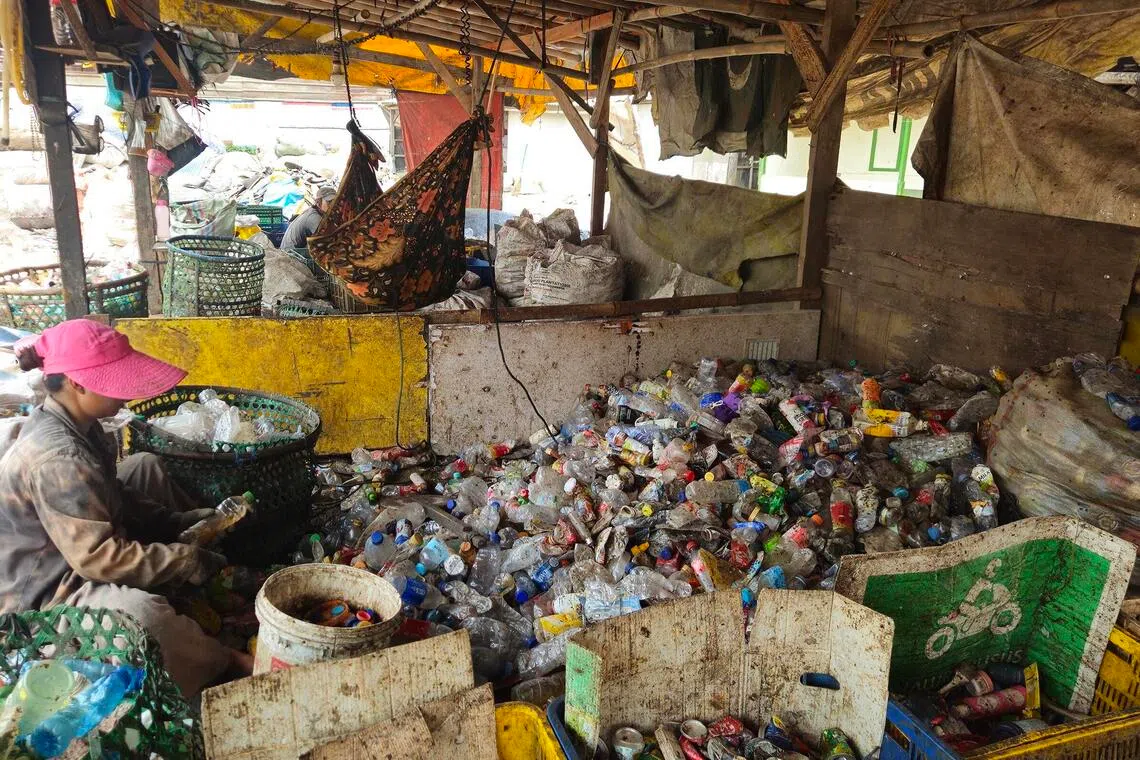
A woman who declined to disclose her identity sorting used plastic bottles for recycling as her baby sleeps in a makeshift swing beside her at a waste collection site in Bantar Gebang, Bekasi.
ST PHOTO: WAHYUDI SOERIAATMADJA
Communities living near landfills face a 40 per cent increased risk of asthma, a sevenfold higher risk of dengue fever, and a 72 per cent increase in diarrhoea due to polluted waters, according to the Danantara note to investors.
Veteran garbage scavenger Abdul Hasib, 52, who migrated to Bantar Gebang in the early 2000s, appealed to the government to rope in the scavengers in the planned new project, such as by allowing them to work in the incinerator facilities.
Mr Abdul left his home town of Madura in East Java after his garment sewing and alteration shop shut. He then worked as a becak (pedicab) driver for a while.
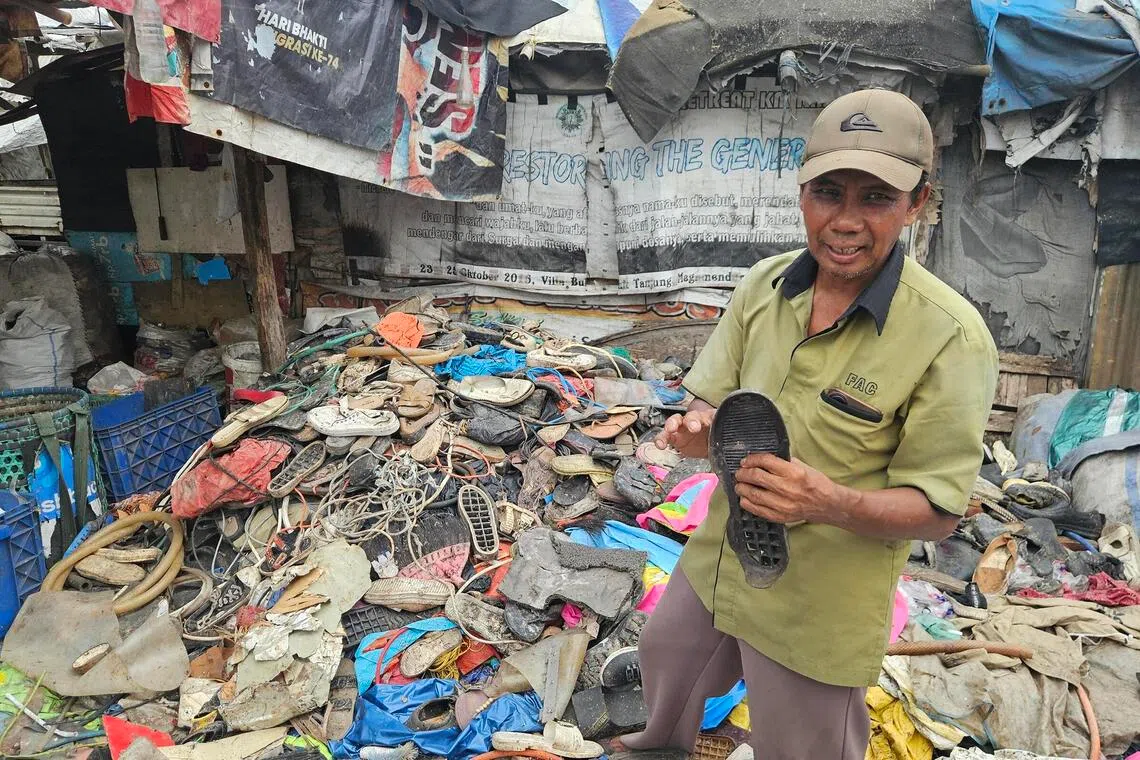
Garbage scavenger Abdul Hasib, 52, starts work around 3am, at the Bantar Gebang landfill, when all the trucks are out for refuelling.
ST PHOTO: WAHYUDI SOERIAATMADJA
He now starts work at the landfill at around 3am, collecting plastic waste, sorting it and selling it to recycling centres for 1,000 rupiah per kg.
“The government shouldn’t overlook us. We play a main role in waste management here too,” Mr Abdul told ST.


